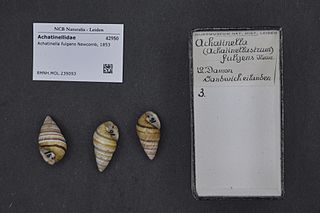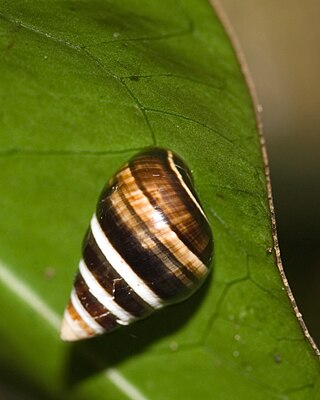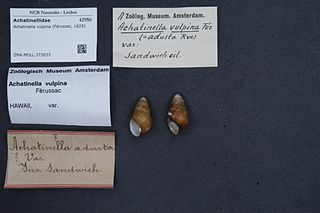
Achatinella is a tropical genus of colorful land snails in the monotypic Achatinellidae subfamily Achatinellinae. Species are arboreal pulmonate gastropod mollusks with some species called Oʻahu tree snails or kāhuli in the Hawaiian language.

Euglandina rosea, the rosy wolfsnail or cannibal snail, is a species of medium-sized to large predatory air-breathing land snail, a carnivorous terrestrial pulmonate gastropod mollusk in the family Spiraxidae.

Achatinella bellula is a species of air-breathing land snail, a terrestrial pulmonate gastropod mollusk in the family Achatinellidae. This species is endemic to the Hawaiian island of Oahu in the United States. No more than five specimens have been observed since 1979.

Achatinella byronii is a species of air-breathing land snail, a terrestrial pulmonate gastropod mollusk in the family Achatinellidae. This species is endemic to Oahu, in the Hawaiian Islands.
Achatinella decipiens is a species of air-breathing land snail, a terrestrial pulmonate gastropod mollusk in the family Achatinellidae. This species is endemic to Hawaii.

Achatinella fulgens is a species of air-breathing land snail, a terrestrial pulmonate gastropod mollusc within the Achatinella genus of the family Achatinellidae. The species is one of a collection of snail species commonly referred to as Oʻahu tree snails or pupu kuahiwi in the Hawaiian language.

Achatinella fuscobasis is a species of air-breathing land snail, a terrestrial pulmonate gastropod in the family Achatinellidae. This species is endemic to Hawaii.

Achatinella lila is a species of air-breathing land snail, a terrestrial pulmonate gastropod mollusk in the family Achatinellidae. This species is endemic to the northern Ko‘olau Mountains, Oahu.

Achatinella mustelina is a species of air-breathing land snail, a terrestrial pulmonate gastropod mollusc in the family Achatinellidae. This species is endemic to the Waianae Range of the island of Oahu, Hawaii.

Achatinella pulcherrima is a species of air-breathing land snail, a terrestrial pulmonate gastropod mollusk in the family Achatinellidae. This species is endemic to the island of Oahu in Hawaii.
Achatinella pupukanioe is a species of land snail, a gastropod in the family Achatinellidae. It is endemic to Hawaii.
Achatinella taeniolata, an O'ahu tree snail, is a species of colorful, tropical, tree-living, air-breathing land snail, an arboreal pulmonate gastropod mollusc in the family Achatinellidae.

Achatinella vulpina is a species of air-breathing land snail, a terrestrial pulmonate gastropod mollusc in the family Achatinellidae. This species is endemic to Hawaii.
Auriculella ambusta is a species of air-breathing tropical land snail, a terrestrial pulmonate gastropod mollusc in the family Achatinellidae. This species is endemic to the Hawaiian Islands. Some can be found in Oahu specifically in Waianae mountains. Many of the land snails goes extinct due to predators like a rodent, mongoose, etc. Over 752 land snails have been pushed into extinction due to these predators. There closest living relative is the Achatinella tree snails which are and bigger is size.

Newcombia cumingi, common name Newcomb's Tree snail, is a species of air-breathing land snail, a terrestrial pulmonate gastropod mollusk in the family Achatinellidae. This species is endemic to Hawaii, the United States.

Achatinellidae is a family of tropical air-breathing land snails, terrestrial pulmonate gastropod mollusks in the superfamily Pupilloidea.

An endling is the last known individual of a species or subspecies. Once the endling dies, the species becomes extinct. The word was coined in correspondence in the scientific journal Nature.
George was a snail of the species Achatinella apexfulva, and the last known individual of his species.

Michael Gale Hadfield is an invertebrate biologist and professor emeritus at the University of Hawaiʻi at Mānoa. His research has focused on the larvae of marine invertebrates and native tree snails in Hawai'i. He retired in 2013, but has remained active in research and was recognized in 2023 as one of the top ecology and evolutionary scientists in the U.S. and the world.














